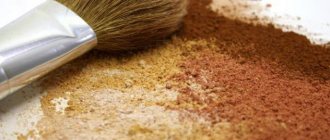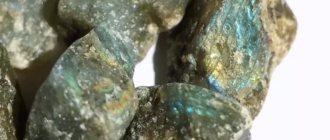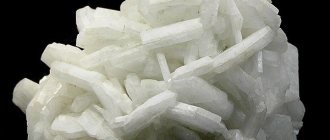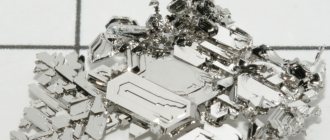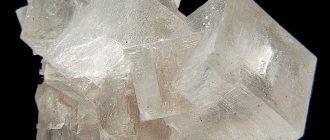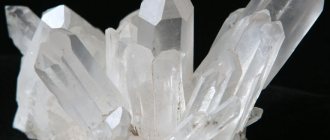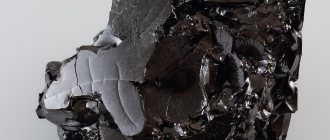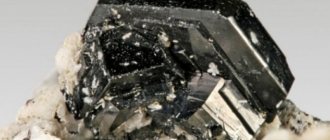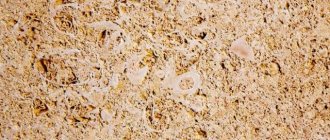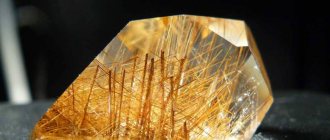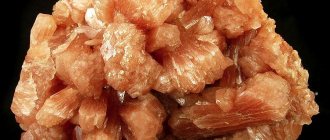Chemical composition
MgO 47.6%, CO2 52.4%. Of the isomorphic impurities, Fe, sometimes Mn, and Ca are most often found. Magnesium can be partially replaced by iron, and magnesite thus gradually turns into siderite. Kruk identified the following intermediate types of magnesite: breunnerite 95 - 70% MgCO3, mesitite 70-50% MgCO3, pistomesitite 50-30% MgCO3, sideroplesite 30 - 5% MgCO3; the rest in all cases is FeCO3. Mechanical impurities, especially in metacolloidal formations, are: SiO2 in the form of opal or chalcedony (up to several percent), Al2O3 in the form of a clayey substance, H2O, and sometimes dolomite (the CaO content in magnesite masses is obviously associated with it).
Crystallographic characteristics
Syngony. Trigonal
The class is ditrigonal-scalenohedral. L33L23PC.
Crystal structure
Magnesite Uzbel massif
Main forms :
The crystal structure is similar to that of calcite.
Physical properties
Optical
- The color of magnesite is white with a yellowish or grayish tint, sometimes snow-white.
- The line is white.
- Glass shine, matte.
Mechanical
- Hardness 4-4.5 (for porcelain varieties up to 7).
- Density 2.9—3.1.
- The cleavage is perfect along the rhombohedron.
- The fracture is granular; dense metacolloidal porcelain varieties are characterized by a conchoidal fracture.
- Fragile.
Magnesite Aznalinskoe deposit
Chemical properties
The solubility of MgCO3 in water is slightly higher than for calcite. At ordinary temperature and atmospheric pressure in pure water it does not exceed 80 mg/l, but in the form of bicarbonate Mg[HCO3]2 the solubility is exceptionally high: at PCO2 equal to 1 at, and at 18° it reaches 25,800 mg/l, i.e., 23 times higher than the solubility of calcium bicarbonate under the same conditions. At PCO2 equal to 56 at, it increases to 74900 mg/l. It is characteristic that when heated it drops just as sharply: at a temperature of 100° and the same PCO2 equal to 1 atm, it is less than 100 mg/l.
It is also important to emphasize the fact that from a solution of magnesium bicarbonate, with a decrease in PCO2 or an increase in t, it is not possible to obtain a precipitate of the normal salt MgCO3, but always a trihydrate - MgCO3 • 3H2O, often in a mixture with basic aqueous magnesium carbonates (due to the pronounced tendency of Mg2+ ions to form complexes with H2O). Over time, these aqueous salts are able to transform into anhydrous normal magnesium carbonate (under conditions of reduced water vapor pressure). It has also been established that the precipitation of magnesium carbonate trihydrate increases sharply with increasing alkalinity of the solution (at pH>8).
It dissolves in acids only when heated. A drop of hydrochloric acid does not “boil” in the cold. Only in fine-grained aggregates, as is typical for other less soluble carbonates (dolomite, siderite, etc.), CO2 bubbles are released after some time. Dissolves in hot acids.
Other properties
Heat of formation: MgO+CO2 = MgCO3+27 240 cal.
Dissociation of MgCO3 during calcination in an air atmosphere occurs at a temperature of 525° (according to the heating curves 600–690°). At elevated carbon dioxide pressures PCO2 = 1-200 atm, magnesite can be stable up to temperatures of 600-700°.
Artificial production of mineral
Magnesite is produced artificially by heating aqueous magnesium carbonates precipitated from solutions. It is interesting to note that when a stream of CO2 is passed through a heated MgCO3 solution, crystals of the orthorhombic modification (unknown in nature) precipitate.
Diagnostic signs of magnesite
Similar minerals. Dolomite, calcite.
Associated minerals. Dolomite, calcite, quartz, opal, talc, olivine, pyrite, chalcopyrite, limonite, galena, sphalerite.
Difficult to recognize. The white solid variety is similar to flint, but has a lower hardness. In crystalline varieties, like all carbonates of the calcite series, they are distinguishable from other minerals by their rhombohedral cleavage. Within the series it is most difficult to distinguish from dolomite, ankerite and other carbonates; one has to resort to optical and chemical studies. It differs from dolomite and calcite in the nature of its reaction with hydrochloric acid.
Magnesite radial aggregates with small quartz crystals
Application in construction
Magnesia binders contain caustic magnesite or caustic dolomite. In the ground state, they are mixed not with water, with which they harden very slowly, but with a solution of magnesium chloride (MgCl2), magnesium sulfate (MgSO4) or some other salts.
Magnesium binders harden in air, so they can only be used where it is dry. They are distinguished by the fact that they firmly adhere to fibrous materials, such as wood, so they are used in combination with shavings to produce thermal insulation material - fiberboard, and with sawdust to produce xylolite. The raw material for the production of caustic magnesite is the magnesite rock, consisting mainly of magnesium carbonate MgCO3. Pure magnesite is much less common than limestone and gypsum.
The production of caustic magnesite consists of two successive processes of firing and grinding.
Magnesite is fired in shaft, rotary and other kilns. The purpose of firing is to remove carbon dioxide from magnesite. Experiments have established that caustic magnesite of the best quality (as a binder) is obtained at a firing temperature of 800-850°.
Grinding of caustic magnesite is most often done in ball mills with air separators to separate fine particles. It is transported in iron drums with a capacity of 150 kg or in bulk in covered wagons, stored indoors, avoiding moisture and contamination.
Caustic magnesite is a fine white or yellowish powder.
Its specific gravity is 3.1–3.4%, i.e., more than ordinary Portland cement.
The magnesium oxide content in it must be at least 83% for the 2nd grade and 75% for the 3rd grade.
The most common binder for magnesium cement is a solution of magnesium chloride MgCl2 6H2O, which is a colorless or slightly yellowish transparent salt.
Origin and location
Magnesite, compared to calcite, is much less common in nature, but is sometimes found in large continuous masses of industrial interest. Some of these accumulations are formed hydrothermally. First of all, this should include very large deposits of crystalline granular masses of magnesite, spatially associated with dolomites and dolomitized limestones. As geological studies show, these deposits are formed metasomatically (among the deposits it was sometimes possible to identify relics of limestone fauna). It is assumed that magnesia could be leached and deposited in the form of magnesite by hot alkaline solutions from dolomitized strata of sedimentary origin. Typical hydrothermal minerals are occasionally found in paragenesis with magnesite: calcite, aragonite, dolomite, barite, talc, chlorite, quartz, pyrite, chalcopyrite, sphalerite, fahlores, etc.
Another type of hydrothermal deposits, also sometimes of practical importance, is associated with the impact of hydrotherms rich in carbon dioxide on massifs of ultramafic magnesian igneous rocks: serpentinites, peridotites, etc. Deposits of fine-crystalline magnesite in the form of lenses, veins, nests and a dense network of veinlets are usually confined to cracks and zones discharges. In the form of inclusions, calcite, dolomite, ankerite, talc, chalcedony, quartz, magnetite, hematite, etc. are observed. The formation of magnesite could occur according to the following scheme:
Mg6[Si4O10][OH]8 + 6CO2 → MgCO3 + 4SiO2 + H2O
The free silica formed in this case is obviously carried away mainly by alkaline waters. Opal, chalcedony and quartz are usually observed in relatively insignificant quantities in the magnesium mass itself.
Accumulations of cryptocrystalline (“amorphous”) magnesite also arise during weathering processes of massifs of ultramafic rocks, especially in cases where intense weathering results in the formation of a thick crust of destruction products. During the process of oxidation and hydrolysis, magnesium silicates undergo complete destruction under the influence of surface water and air carbon dioxide. The sparingly soluble iron hydroxides that arise accumulate at the surface. Magnesia in the form of bicarbonate, as well as released silica in the form of sols, sink into the lower horizons of the weathering crust. In this case, blurred zones of neoplasms may appear, gradually transforming into each other. Magnesite , often enriched in opal and dolomite, is deposited in the form of veinlets and accumulations of sinter forms in highly leached fractured porous serpentinites in the zone of stagnant groundwater.
Finally, finds of magnesite with hydromagnesite, for the most part of mineralogical significance, are observed among sedimentary salt-bearing deposits. The formation of magnesium carbonates is associated with the reaction of exchange decomposition of magnesium sulfate with Na2CO3. Magnesite is also found in gypsum-bearing sedimentary strata.
Magnesite. Granular aggregate
There are two ways to produce magnesium chloride:
- extraction from sea water condensed as a result of evaporation - from sea estuaries or salt lakes
- obtained from chemical plants as waste during the production of potash fertilizers.
In addition to magnesium chloride, solutions of magnesium sulfate, sodium acid sulfate, iron sulfate, and natural mineral can be used as sealants. carnalite, as well as sulfuric and hydrochloric acids. However, magnesium binder mixed with magnesium chloride has the highest strength, and slightly lower strength if mixed with carnalite or magnesium sulfate. Magnesium sulfate has the advantage over other binders that it makes the magnesium binder less hygroscopic.
When caustic magnesite is mixed with a solution of magnesium chloride or other salts mentioned above, setting and hardening occur, which accelerate with increasing temperature. Magnesia binder is used in construction mainly in combination with organic fillers (wood shavings and sawdust), since it does not cause decomposition of organic substances and provides good adhesion to them.
Under the influence of water, this binder is destroyed, as soluble salts are washed out of it.
Magnesium binder is tested for setting time, uniformity of volume change and strength.
The test procedure is the same as for ordinary cement, but with the following changes:
- dough of normal thickness is prepared from magnesite mixed with a solution of magnesium chloride with a specific gravity of 1.20;
- samples are stored not in water, but in air at normal room temperature and humidity;
- strength is tested only in tension, and the composition;
- The solution includes magnesite and pine sawdust in a ratio of 3: I (by weight).
Magnesium binder is characterized by the following properties:
- the beginning of setting no earlier than 20 minutes, the end no later than 6 hours. from the beginning of the retreat;
- tensile strength after 24 hours is not lower than 15 kg/cm2;
- magnesia solution with pine sawdust of composition 3: 1 (by weight) of plastic consistency after 28 days usually has a compressive strength of 200 to 300 kg/gm2, which corresponds to the strength of high grade cements
Thus, magnesium binder sets normally, hardens quickly in air, has noticeable strength after just 24 hours and high strength after 28 days.
Place of Birth
The famous Satka deposit of crystalline magnesite, of hydrothermal origin, is located on the western slope of the Southern Urals (50 km southwest of the city of Zlatoust). Large magnesite deposits were formed metasomatically among dolomite sedimentary strata of Precambrian age. Similar deposits are known in the Far East, Southern Manchuria, Korea, Austria (Weitsch, in the Alps, south of Vienna), the Czech Republic, Canada (Quebec) and other places.
A large deposit of magnesite of hydrothermal origin among serpentinite massifs is known on the island. Euboea in the Aegean Sea. Deposits formed in the ancient weathering crust of ultrabasic rocks include Khalilovskoye in the Southern Urals.
Practical use
In metallurgy, “tightly” burnt crystalline magnesite is used to make refractory bricks that can withstand temperatures up to 3000°. They are used in the laying of the lower parts of the hearth of open-hearth furnaces, converters, cement kilns, etc. The second area of application of burnt magnesite is the production of the so-called Sorel cement, used in the abrasive industry (grinding wheels) and in construction (resistant plaster mixed with sand, gravel, sawdust, diatomaceous earth, talc and other fillers). It is also used for the production of electrical insulators, in paper, sugar, rubber and other industries.
Application of magnesium cement for plaster mortar
The binder in magnesium cement plasters is caustic magnesite with an activity of 600-1000 kg/cm2. Instead of caustic magnesite from normal firing, waste from the so-called dead firing of magnesite can be used.
The main requirement for caustic magnesite, whether normally fired or in the form of waste, is high grinding fineness. The finer the grind, the higher the astringent properties of caustic-fired magnesite and its ductility. Magnesium chloride or magnesium sulfate can be used as a sealer. The latter gives slightly less strength, but at the same time less hygroscopic plaster.
All types of inert materials used in stone and lime-sand plasters can be used as a filler in magnesium plasters. The addition of low grade microasbestos is also used. In order to increase sound and heat insulation properties, organic fillers in the form of wood flour and sawdust can also be introduced. The dyes for magnesia binder are the same mineral pigments as for coloring Portland cement, with the exception of ultramarine.
